JMicron JMF667H Reference Design (128GB & 256GB) Review
by Kristian Vättö on May 29, 2014 9:00 AM ESTRandom Read/Write Speed
The four corners of SSD performance are as follows: random read, random write, sequential read and sequential write speed. Random accesses are generally small in size, while sequential accesses tend to be larger and thus we have the four Iometer tests we use in all of our reviews.
Our first test writes 4KB in a completely random pattern over an 8GB space of the drive to simulate the sort of random access that you'd see on an OS drive (even this is more stressful than a normal desktop user would see). We perform three concurrent IOs and run the test for 3 minutes. The results reported are in average MB/s over the entire time.
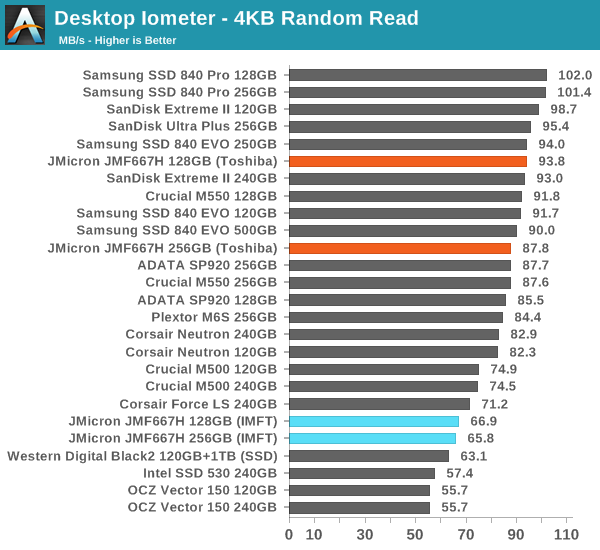
Once again there is quite a big difference depending on what NAND is used. With Toshiba NAND, the JMF667H is at the same level with the high-end drives but IMFT NAND drops it to the lower-end. From what I have heard, Toshiba's NAND is faster in general and the higher die count further boosts performance.
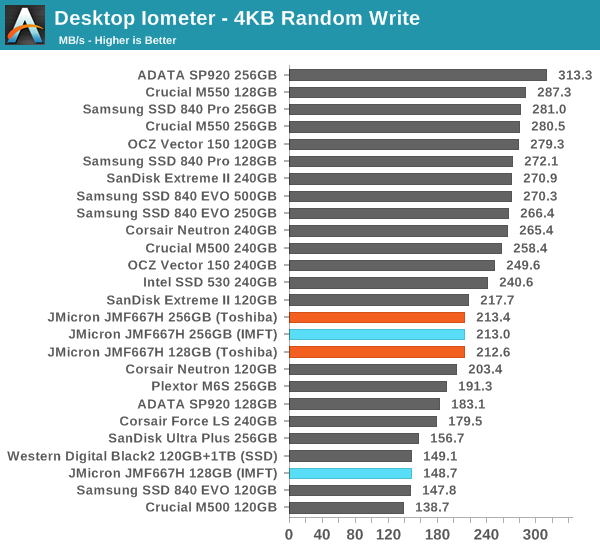
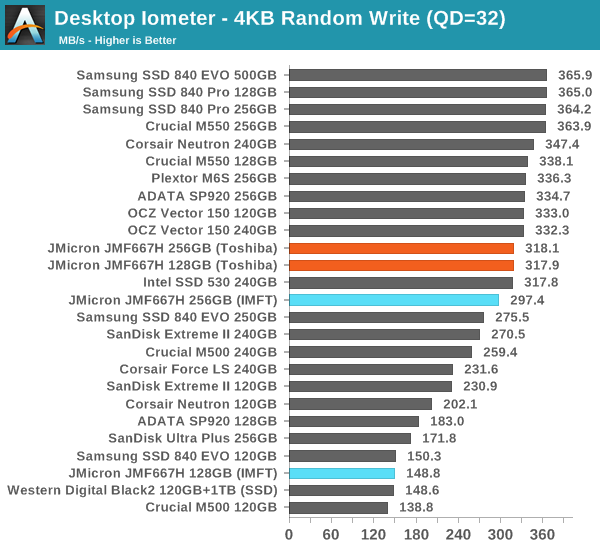
Random write performance is fairly average. I'm guessing the controller/firmware introduces some bottlenecks because the performance isn't really affected by the NAND other than in the 128GB configuration.
Sequential Read/Write Speed
To measure sequential performance we run a 1 minute long 128KB sequential test over the entire span of the drive at a queue depth of 1. The results reported are in average MB/s over the entire test length.
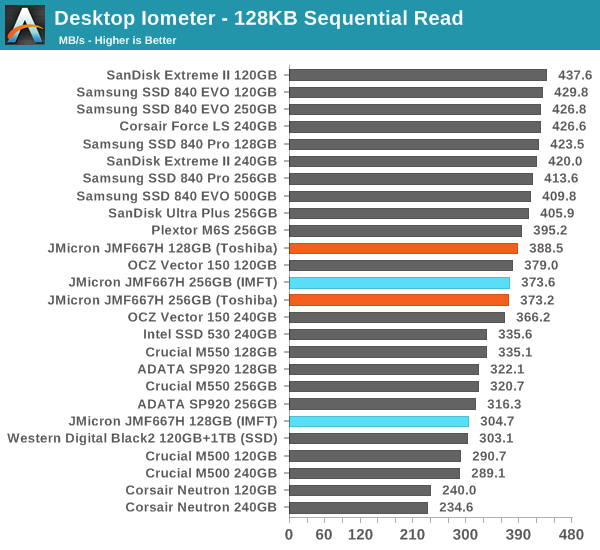
Sequential performance is also average. There is some variation especially in write performance depending on the NAND but even the IMFT version performs relatively well.
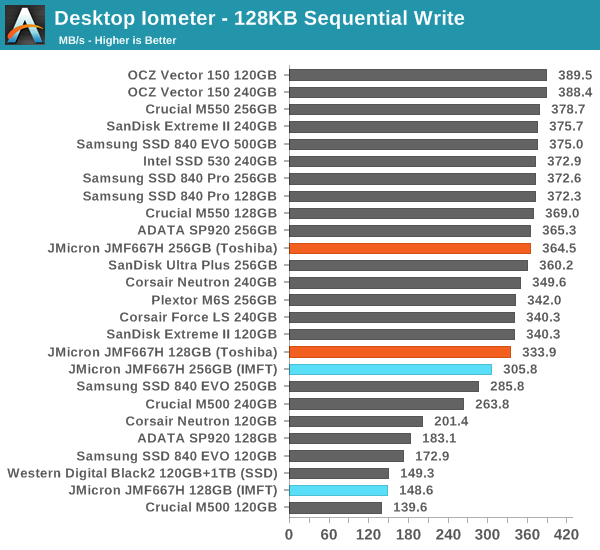
AS-SSD Incompressible Sequential Read/Write Performance
The AS-SSD sequential benchmark uses incompressible data for all of its transfers. The result is a pretty big reduction in sequential write speed on SandForce based controllers.












28 Comments
View All Comments
Bindibadgi - Friday, May 30, 2014 - link
I'm genuinely wondering if the photos are artistically filtered or simply just that bad??hp79 - Friday, May 30, 2014 - link
I think it's being artistically shot that way. I don't like it either. Photos from AMD article looks fine.Nice article though. Good to see another contender in SSD market, back from the hall of shame.
It's going to be tough though. After sticking a Samsung 840 Pro 256GB in my desktop, and getting a rMBP13 laptop which has proprietary crazy fast SSD, I'm no longer in the market. But if I were to buy another SSD, it'll be whoever is cheapest (after rebates and coupons) with reasonable performance. And it should be a 7mm height so it also fits modern ultra thin laptops, not stupid 9.5mm with no reason.
Kristian Vättö - Friday, May 30, 2014 - link
Better now? I was in a hurry last night as the deadline was approaching way too quickly, so the quality suffered as a result. Bear in mind that we all work from our homes, so the camera equipment and lighting differs greatly from review to review.MrPoletski - Friday, May 30, 2014 - link
For the love of god, why is it that on every SSD review here, every time I look at the performance consistancy graphs it is always for 4KB random write QD32?3 separate tabbed graphs, all saying 4KB random write QD32 - yet clearly only one of them is, the others being perhaps 4kb reads, or 4kb writes QD 1 or 2.
It's this way every time I read an SSD review on anandtech, has nobody noticed this and fixed it yet or what?
MrPoletski - Friday, May 30, 2014 - link
haha, this time there was an explanation in the article. Ok. IGNORE ME LOL.milli - Friday, May 30, 2014 - link
'Micron's roadmaps showed that a SATA 6Gbps JMF66x series was planned for the second half of 2010, which made sense given that Intel was integrating SATA 6Gbps to their 6-series chipsets in early 2011. But for some reason, the JMF66x never made it to the market on time.'I don't think that's entirely true.
The Kingston SSDNow V200 used a JMicron JMF661 or JMF662 controller. That product launched towards the end of 2011 with great difficulties. The controller wasn't broken but the firmware was. It took Kingston six months to release a firmware that fixed the problems. Before that firmware the drive was utterly unusable (paused up to 5 seconds sometimes). After the firmware update it became usable and speed was then as advertised.
You can read about it here: http://forum.notebookreview.com/solid-state-drives...
This was very weird because the JMF618 found in some Kingston drives, worked very well (as found in Anand's reviews).
As for the JMF667H, I've used two Transcend SSD340 256GB drives. I suppose they are using the old firmware but performance is okay. Using those systems feels more or less like a system with a M500. Nothing earth shattering.
go4aBetterPC - Friday, May 30, 2014 - link
While nice, I think JMicron is late to the market by about 1 to 2 years. For example the Micron M500 is already on the market. I would just use a another controller such as Marvell. Competitors are announcing and eventually releasing PCIe controllers. Intel has been slow to invigorate the PC market. Perhaps they are too distracted by all their Broadwell yield delays. And some key providers like Micron are trying to make their own controllers or already do in the case of Samsung, but already have relatively low cost SSD drives on the market. Perhaps JMicron should look for a buyer. The SSD market is highly competitive and there are lots of players and interest. I am hoping laptop manufacturers get their act together and start offering more ssd drives as a option. I have decided to not buy many laptops since they don't offer a 128gb or 256gb ssd drive. To me, this is the main way to invigorate the market. Too many companies wait for new Intel processors rather than take control of their own destiny. A $500 laptop that now costs $650 with a ssd would get good reviews and probably would gather a lot of sales.Shiitaki - Wednesday, June 4, 2014 - link
I just recently picked up a Samsung Evo for school for virtualizing a cluster of computers. I ended up going with the Samsung for 3 reasons. One, consistently high performance, it's the 1TB version. Two, single manufacturer of the whole item, they don't source parts from 'whomever is cheaper'. I'm thinking of Kingston here. There are plenty of reviews of the drive, Samsung is proud of it, so plenty of reviews available.I looked at the Optima, a pair of them in fact. But I could only find one review, and I also didn't want to buy something where the review sample is superior to what they are selling to the consumer. While it was cheaper, I didn't have faith that PNY wouldn't do what Kingston has been caught doing.
The importance of your website to the consumer is huge. I'd like to express my appreciation for Anandtech.com's constant diligence. If I can't find a review on something with measurements, I won't buy it.